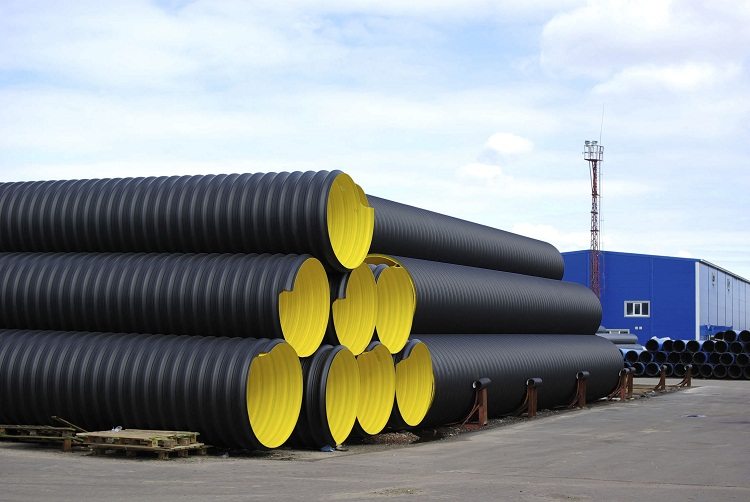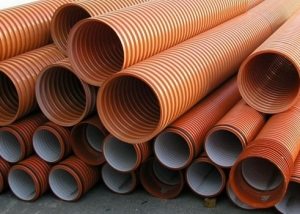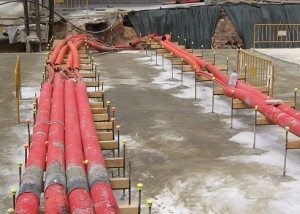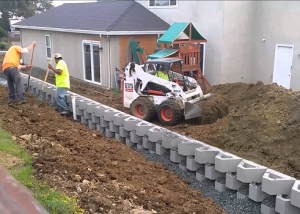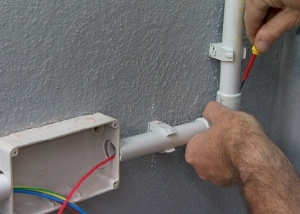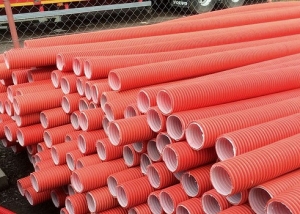Road construction is often accompanied by solving complex problems that require overcoming various conditions. So, for example, an incorrectly formed level of the route relative to the landscape in combination with precipitation or spring flood can cause flooding. One of the simplest solutions for wastewater disposal is a deepening dug along the road on two sides - a ditch for collecting water from the highway and the territory adjacent to it. But then another problem arises: how to overcome this moat if a house or a summer cottage is located in this adjacent territory?
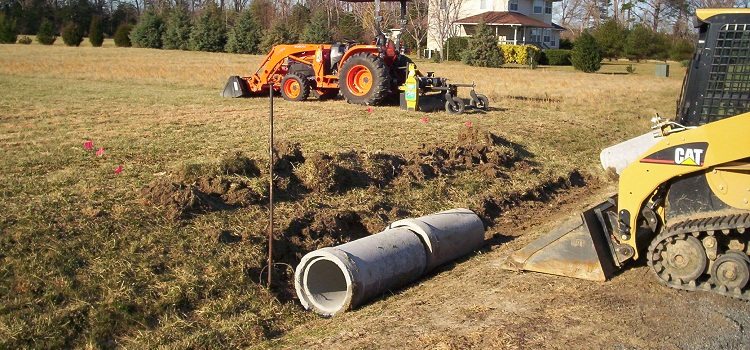
For laying in a ditch, you need to choose high-strength pipes, because the load on them will be large
Content
Choice of pipe for a ditch on a race
To solve the problem of water accumulation and passage through such a site will help laying a pipe in a ditch for a race. That's right, since you can’t just fill up the recess, water will accumulate or erode the embankment in a stream. For effective drainage without obstruction of the outflow, a pipe is placed in the trench, or a connection of several pipes, depending on the width of the race. Then, an embankment is formed over the formed flow channel, which will ensure the passage of transport from the highway to the site. This, at first glance, a simple construction actually requires a serious approach and some engineering calculations.
There are a number of conditions that affect the choice:
- the entry of heavy vehicles (truck, dump truck weighing 20t + 10t cargo) due to ongoing construction work or other needs on the site requires endurance pipelines with large, frequent loads;
- the depth and width of the ditch affects the choice of diameter, depending on the volume of accumulated water, it can be a trench 1 m deep and 2 m wide or a ditch;
- construction budget, as the cost of materials, delivery and installation method varies.
Important! A narrow and long pipe is more often clogged, and it is rather difficult to clean it.
Corrugated Plastic Pipe for Ditching
Now quite common, credible material. It is a double-walled product with a diameter of 200 to 1000 mm with a wall thickness of 22 to 140 mm, a length of 1 to 6 m. The layers are soldered together seamlessly. Raw materials - high-density primary polyethylene or polypropylene.
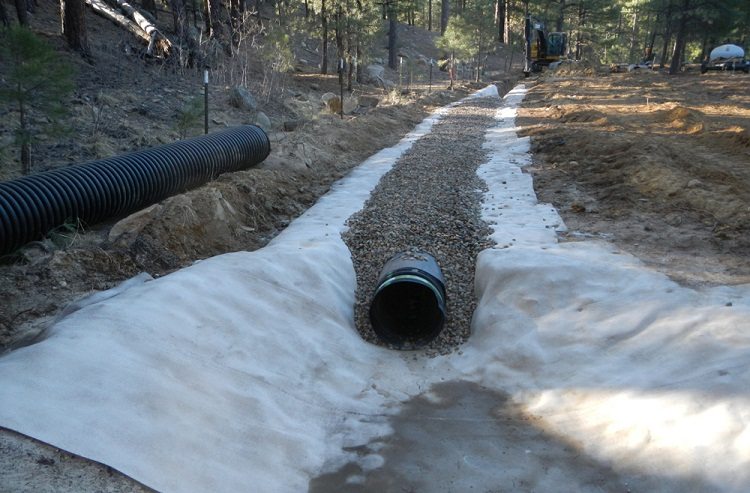
Corrugated pipes for laying underground are double-walled products characterized by high pressure resistance
The use of pre-processed (secondary) raw materials, or the mixing of a large amount of them with the primary in the manufacture of plastic products leads to a decrease in their elasticity. The elasticity of the corrugated pipe placed in the ditch is recommended to be checked by pressing on the rib, the dent will not take the previous shape due to the abundance of impurities. The outer corrugated layer is a lightweight protective frame, with which the manufacturer achieves greater rigidity and wall thickness without adding a volume of raw materials (heaviness) with a rise in price. A small spring effect with external load allows the pipeline to maintain integrity and shape.
The stiffness index of a plastic pipe is indicated as SN (nominal stiffness) and is 4; 6; 8 and 16kH / m2 (it is used for various conditions of laying, beginning from the seasonal dacha, finishing with an airdrome). This value determines the strength of the pipe products (the degree of deformation at a pressure per square meter), the possible depth of its laying (2-8m).
Elasticity is an important quality inherent in plastic, since under the pressure of soil freezing in winter, as well as moving machines, a plastic pipe can slightly change shape with insignificant internal stress, then return to its original state (but not at -50aboutWITH). If the trench has a slope, the inner smooth layer provides an unhindered flow of water with self-cleaning, and if not, then cleaning the plastic pipe is greatly facilitated by the smoothness, since silt and debris does not grow to the walls.
At its low cost, a corrugated plastic pipe (for laying on a race or in any other trench) has excellent characteristics: lightness, resistance to oxidation, as well as most chemicals, no corrosion, operating temperature from -35aboutC to 75aboutC, resistant to deformation, high ring stiffness 6-8kH / m2 (indicator 8 guarantees laying under the highway or repeated passage of heavy equipment), the service life is 50+ years.
Simple transportation, cutting, installation without using PTM, docking (also with pipes from other materials) makes it possible to carry out work independently or with a pair of assistants. It is easy to adjust the length to the required value - to saw or increase it with the help of couplings. Plastic pipes are affordable and attractive in price when compared with other analogues.
Among the weaknesses can be called destruction by ultraviolet radiation (not all manufacturers take this factor into account when manufacturing pipes), but also by contact with the flame.
Reinforced concrete pipes for a ditch on a race
They look impressive, quite common in construction, inspire confidence, are in high demand. Such a pipe consists of a reinforcing frame (wire, reinforcement) poured with heavy concrete of grade M 350 so that the product becomes monolithic. The production is based on centrifuge and vibropressing methods. The latter method provides the best performance: high strength, smoothness. Concrete, due to its density, reliably protects the inner metal frame from corrosion. Non-pressure reinforced concrete pipe for a ditch can have the following dimensions: diameter from 300 to 1200 mm, wall thickness from 140 to 400 mm, length 2.5-5 m, weight from 0.5 to 5 tons.
The compressive stiffness class is standardized, indicated as:
- B30 - 1, 2, 3 group of bearing capacity (height of the soil embankment 2, 4, 6 m above the pipe);
- B40 - 4, 5 group bearing capacity (height of the embankment 8, 10 m above the pipe).
Concrete should have water resistance (W6), water absorption (not higher than 6% by weight), and frost resistance (F200).
Important! High-quality dense concrete of high uniformity prevents the deformation of the pipeline caused by the movement of water inside the concrete (absorption / evaporation, freezing / thawing).
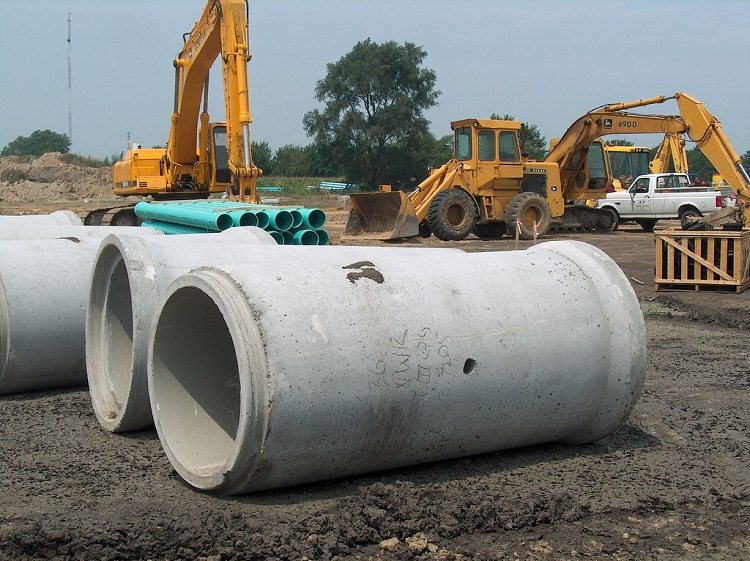
Reinforced concrete pipes are very durable, but installation work is complicated by the heavy weight of such products.
Performance characteristics of reinforced concrete pipes for a ditch on a run: high strength, resistance to loads (static, dynamic), shape stability, no oxidation and corrosion, resistance to aggressive chemical, biological effects, smoothness of the inner surface, heat resistance, operating temperature from -60aboutC to 200aboutC, service life 60-100 years.
The large dimensions and weight of the pipes are the main source of difficulties. Independent work is impossible, you need to use special equipment during transportation and installation, which in turn require caution and additional costs.
Step-by-step pipe laying in a ditch for a race
The main task in the installation process is the passage of water strictly through the pipeline, preventing the washing of the soil.Therefore, strict adherence to technology will ensure long-term service of the facility without problems.
Basically, for the construction of the race, a pipe with a diameter of 350-500 mm is used, since a diameter of 200 mm is already difficult to clean. It is not known what condition they are in, under what conditions they were used to use pipes that were previously not desirable.
Consumables: pipe, sand, gravel, geotextiles, gravel 5 20, concrete mix.
Here are some stages of the work:
1. Preparation.
- measuring the recess, the required width of the race;
- marking the site of work;
- clearing, leveling the bottom and forming sloping slopes of the recess;
- selection / purchase of a pipe for a ditch on a race.
2. Work before laying.
- to cover the walls and bottom of the ditch with geotextiles, which will retain the shape of the structure, protect against erosion, and prevent the embankment from mixing with the ground;
- make the first layer of the embankment from sand or sand mixture, distributing it along the bottom within the marking. Layer thickness 20 cm;
- the soil at the bottom of the ditch can be unsteady, then at first it is recommended to dig another 10-15 cm deep and fill it with gravel;
- if the ditch is not gravity, that is, the water in it stagnates, a layer of sand should be formed so that the pipe rises above the bottom of the ditch and has a slope of 2 cm, elevation will also be appropriate in case of shrinkage.

It is very important to properly prepare the trench for laying the pipe, otherwise the system will not function as it should
3. Laying a pipe with a diameter of 500 mm in the center of the trench.
- at the bottom of the ditch, at the ends of the pipe, you can dig 30 cm of the recess, fill the recess with gravel. These barriers will protect against sludge;
- It is recommended to immediately build formwork from the boards on both sides of the race, leaving the ends of the pipeline open to hold the embankment. Subsequently, the sidewalls are poured with concrete.
4. Work on the formation of the embankment.
- thoroughly fill the pipe with sand, above it should be at least 30 cm of sand after manual tamping. Sand will evenly distribute the load on the entire surface;
- the second layer - 20 cm of small gravel, level and tamp.
- the third layer is gravel;
- the fourth layer is sand or small gravel.
Important! Layers of bulk material above the pipeline should be at least 50 cm for traffic. Final concreting or asphalting of the race should be done after settling of the embankment after some time. The places of subsidence should be leveled with crushed stone.
5. Concreting the sidewalls of the race. It is necessary to produce it, leaving the pipe ends open (concrete solidifies within a month).
The pipe into the ditch can be protected from clogging by installing metal nets at its ends, so you do not have to scrape large debris each time (leaves, branches, bags, etc.).
So, the long-term operation of such a structure as driving through a ditch with the installation of a flow pipe depends primarily on the quality and working properties of the pipe itself, as well as on a competent approach to the installation process. There are many installation methods, we considered the standard, but they have one principle - this is to prevent water from swamping the site and to ensure reliable travel without obstacles.
